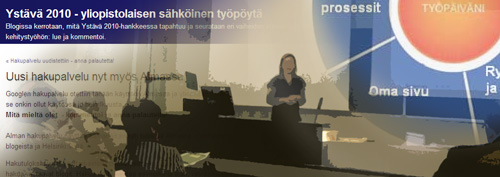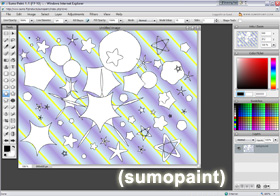
A friend in need is a friend indeed
I attended the Nettifoorumi meeting in the main university building to catch up on the latest developments regarding the web services at the University of Helsinki. One of the big things on the agenda is the upcoming Ystävä (= friend) intranet that will gradually replace the infamous Alma (= a Finnish female name, like “Thelma & Louise” but make it “Alma & Louise”… or, it might just refer to something in latin…) intranet starting in 2010 – at least that’s the plan. Ystävä seems to borrow a lot of ideas from social sites like Facebook and Netvibes, and what with the social web being all about sharing ideas… fine by me 😉 The user interface of Ystävä is marketed as being developed using the experiences from user group testing which sounds good in one way, but I hope the groups really will have a long enough time to actually live with the interface so they spot the real problems that surface in routine use after days or weeks. Oh, and hopefully at least one of the UI designers is a genius.
The difficulty of finding things in Alma is the biggest negative criticism aimed at the current intranet (according to some survey presented at the meeting). The challenge is to hide the stuff that isn’t critically important but still making it possible to find it when it’s needed – the new search function (by Google) has recently been implemented for both internal and external sites, and it certainly helps when searching for the more obscure stuff. Like Alma, the new Ystävä intranet will offer targeted content for the user according to his/her/its (you never know, there might be AI:s or aliens among us) role, with content classes spread over several tabs. Hopefully your own customized page can be set as the first/only page, as I personally only want the stuff I actually use to show up and keep the rest out of sight. One of the ideas presented was the ability to have a separate public and private page, maybe a bit like universes in Netvibes [netvibes.com] or a LinkedIn -page for possible contacts so that they know what your publications etc. are. Also capitalizing on RSS feed functionality is in the works, which is great as Alma currently offers only rudimentary RSS capabilities. And of course integration with most of the other systems (like Moodle, Wiki, WebTraveller, UPJ… there are lots of them on all levels) is planned, hopefully one login will be all it takes to access everything.
Lonely university searches for CMS, please reply
A big part of the upcoming Ystävä intranet is of course the actual content management system (CMS), which will also later on be used for publishing the external www-site. An evaluation round of potential suppliers has been made, and the process now continues to the next critical phase – choosing the supplier. Hopefully the winning bid will do a good job with the system, the CMS used in Alma is a POS. The external site is currently built and updated with Dreamweaver templates, which is fine and dandy for web geeks but errors and synchronization issues and layout blunders happen too often even for simple matters, so a good CMS is for most people probably much better as they can just focus on the actual content side of things while forgetting about the code and layout.
Heaven and Hellsinki
Antti Tolonen from advertising agency Taivas (the “heaven” part I was referring to) had a talk about the current trends in web media; nothing really new if you follow the field (blogs, wikis, twitter etc.) but it’s always nice to hear someone involved with actual money being inspired about the stuff we try to get teachers excited about, and his insights and ideas about site design from the business side of things were nice to hear – esp. as our university gradually looks to become more of a business entity as well (I’m a bit sceptical about all organizations trying to conduct their processess like commercial entities as business is always just about making money and not caring about society, but that’s another subject).
Then Susanna Rautio followed with an interesting presentation of what surveys say about the international appeal of our www-pages. Basically, the visual appeal was criticized and there was too much information and too few bells and whistles (even if I personally don’t care for flash-y presentation videos made with six figure budgets). We then had a short workshop about how to improve the international appeal of the pages, which was helpful in seeing what the problems are and what the solutions can be – hopefully this information will be used by the arrangers. Of course a big problem here is that resources for making pages in English (or Swedish for that matter) are scant. The actual content is always on the Finnish pages, while the other two supported languages mostly get some translations of the (hopefully) most important stuff – therefore, some management of what kind of targeted English content is put out is needed because the resources for translating everything aren’t there. Also, having professionally taken photos is important in making the site look good (more important than flash) and so, finally a photo repository for our use was presented with sets of rights-cleared photos. Much appreciated, great!
In addition to search functions, Google seems to have penetrated our university with Google Analytics, so now we finally know who’s watching us. Nice! Spring is here, the seeds have been sown and we’ll see what has bloomed and what the harvest will be like later on – now go out and enjoy some sunshine [youtube.com] 🙂
Links:

 So, like my colleague
So, like my colleague  However, it might be easy to accidentally mix private and open communication if you use certain social web services and try to keep certain aspects closed from others. Now, the point in this short story was actually the news I read today about a team from the University of Texas at Austin who have developed a method (algorithm) for finding out the identity of a Twitter (or other social network service) user. Basically, it all boils down to getting a few sets of anonymized information about you and seeing to which real person(s) it points – there are bound to be some clues somewhere. This is just stuff that makes you think about identity theft, and what a problem (or at least nuisance) it will be in the future, right now it might not be it but soon it could be. And let’s not forget real, physical theft, if you’re twittering (tweeting?) about being on holiday so burglars can enter your house safely 😉 Simply put – you cannot trust that leaving your name out is the way to be anonymous if you still are connected to other services/persons you or your friends use with any clues about your real identity.
However, it might be easy to accidentally mix private and open communication if you use certain social web services and try to keep certain aspects closed from others. Now, the point in this short story was actually the news I read today about a team from the University of Texas at Austin who have developed a method (algorithm) for finding out the identity of a Twitter (or other social network service) user. Basically, it all boils down to getting a few sets of anonymized information about you and seeing to which real person(s) it points – there are bound to be some clues somewhere. This is just stuff that makes you think about identity theft, and what a problem (or at least nuisance) it will be in the future, right now it might not be it but soon it could be. And let’s not forget real, physical theft, if you’re twittering (tweeting?) about being on holiday so burglars can enter your house safely 😉 Simply put – you cannot trust that leaving your name out is the way to be anonymous if you still are connected to other services/persons you or your friends use with any clues about your real identity. If you need to draw pictures and do some simple photo editing, you might want to try out some free web utilities that run directly from your browser (usually requiring the Adobe Flash Player), and can load/save files on your computer or some image storage service, depending on which application you try. These are no substitution for a real paint program, but can be helpful creative tools when you are working on a computer without your usual favourite programs installed or don’t have the money for them.
If you need to draw pictures and do some simple photo editing, you might want to try out some free web utilities that run directly from your browser (usually requiring the Adobe Flash Player), and can load/save files on your computer or some image storage service, depending on which application you try. These are no substitution for a real paint program, but can be helpful creative tools when you are working on a computer without your usual favourite programs installed or don’t have the money for them.